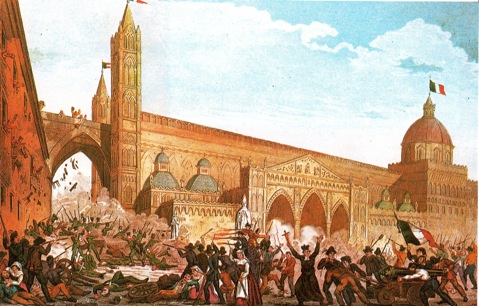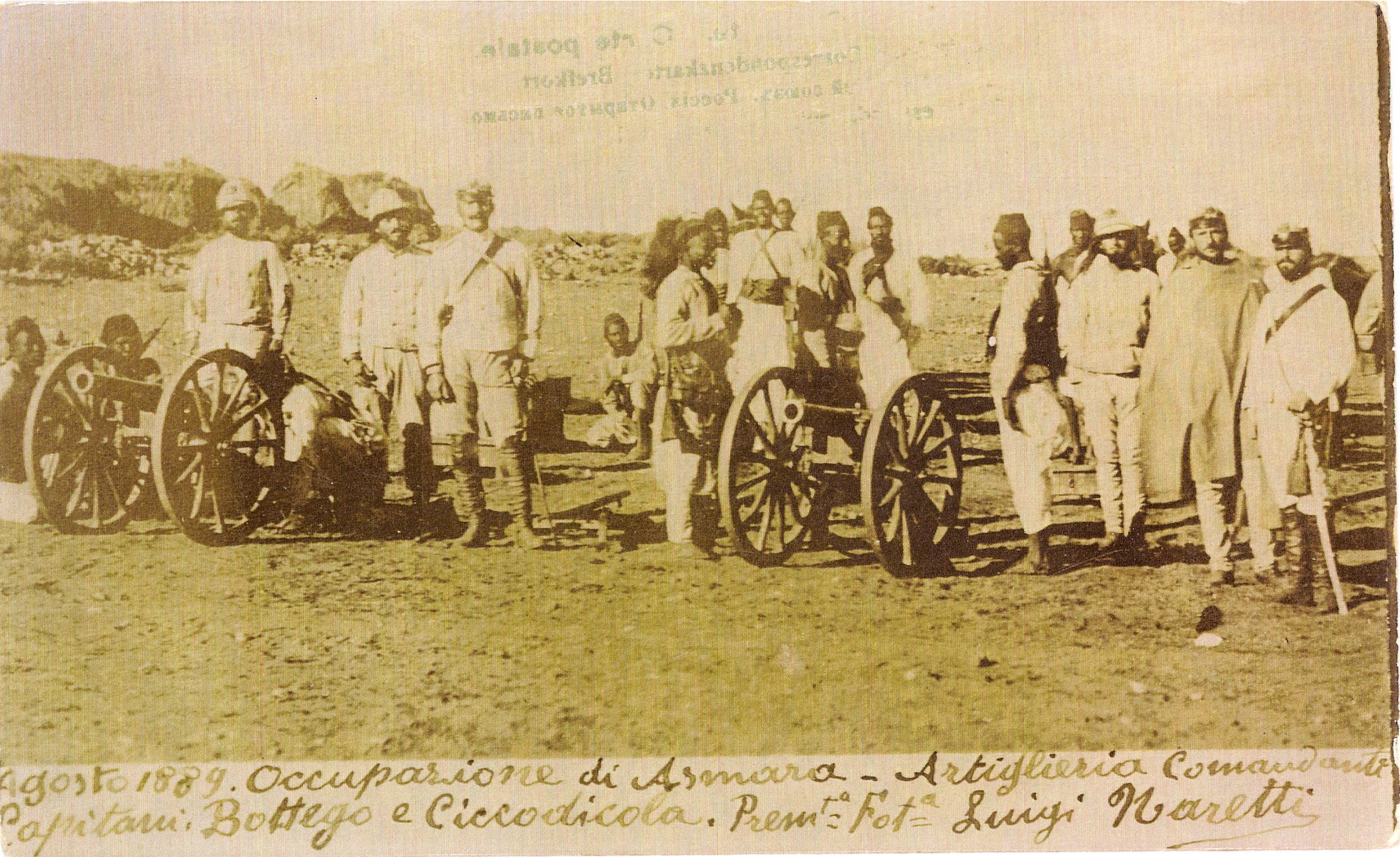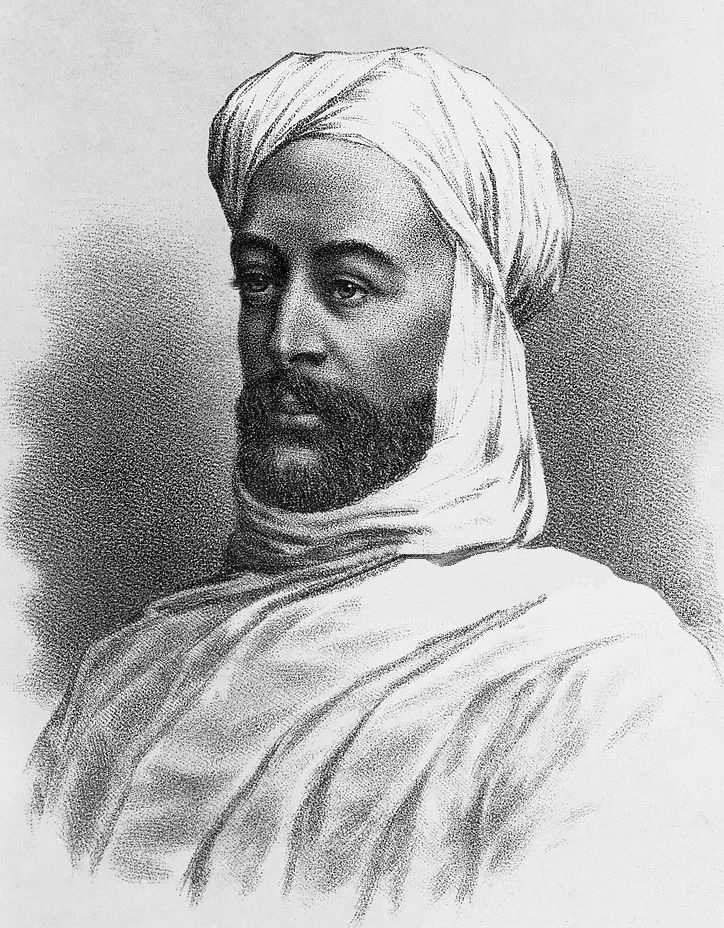|
Oreste Baratieri
Oreste Baratieri (né Oreste Baratter, 13 November 1841 – 7 August 1901) was an Italian general and governor of Italian Eritrea. Early career Born in Condino (County of Tyrol, now Trentino), Baratieri began his career as a volunteer for Giuseppe Garibaldi's Redshirts, where he served during the Expedition of the Thousand from 1860 to 1861. Following the unification of Italy, Baratieri did fight in the Battle of Mentana (1867) then he pursued a military career joining the regular Italian Army and fighting at the Battle of Custoza on 24 June 1866. Rising to the rank of general by 1891, Baratieri was appointed commander of Italian forces in colonial Africa and the following year became governor of Eritrea. Baratieri would spend several years fighting with local Ethiopian forces along the border from 1893 to 1895, winning several victories over the Mahdists, particularly at the Battle of Kassala on 17 July 1894. Italo-Ethiopian War Following Ethiopian Emperor Menelik II and Ital ... [...More Info...] [...Related Items...] OR: [Wikipedia] [Google] [Baidu] |
List Of Colonial Governors Of Eritrea
List of Provincial, Colonial and Federal Heads of Eritrea (Dates in italics indicate ''de facto'' continuation of office.) List of rulers List of Ottoman governors of Egypt (1517–1805) *List of Ottoman governors of Egypt List of monarchs of the Muhammad Ali dynasty (1805–1914) List of Grand Viziers of Egypt (1857–1878) * Zulfiqar Pasha (1857–1858) (1st term) * Mustafa Naili (1858–1861) * Zulfiqar Pasha (1861–1864) (2nd term) * Raghib Pasha (1864–1866) (1st term) * Muhammad Sharif Pasha (1866–1867) (1st term) * Raghib Pasha (1867–1868) (2nd term) * Muhammad Sharif Pasha (1868–1872) (2nd term) * Nubar Pasha (1872) * Muhammad Tawfiq Pasha (1872–1878) Habesh Eyaleti (Ottoman Province of Habesh) / Massawa Province Wali = ''Governor'' Eritrea List Before the official creation of Italian Eritrea (''Colonia Eritrea'') in 1890, the territory had seven interim governors: Giovanni Branchi (1882 to 1885), Alessandro Caimi (1885), Tancredi ... [...More Info...] [...Related Items...] OR: [Wikipedia] [Google] [Baidu] |
Sauria
Sauria is the clade containing the most recent common ancestor of archosaurs (such as crocodilians, dinosaurs, etc.) and lepidosaurs ( lizards and kin), and all its descendants. Since most molecular phylogenies recover turtles as more closely related to archosaurs than to lepidosaurs as part of Archelosauria, Sauria can be considered the crown group of diapsids, or reptiles in general. Depending on the systematics, Sauria includes all modern reptiles or most of them (including birds, a type of archosaur) as well as various extinct groups. Sauria lies within the larger total group Sauropsida, which also contains various stem-reptiles which are more closely related to reptiles than to mammals. Prior to its modern usage, "Sauria" was used as a name for the suborder occupied by lizards, which before 1800 were considered crocodilians. Systematics Recent genomic studiesCrawford, Nicholas G., et al. "More than 1000 ultraconserved elements provide evidence that turtles are the sister g ... [...More Info...] [...Related Items...] OR: [Wikipedia] [Google] [Baidu] |
Francesco Crispi
Francesco Crispi (4 October 1818 – 11 August 1901) was an Italian patriot and statesman. He was among the main protagonists of the Risorgimento, a close friend and supporter of Giuseppe Mazzini and Giuseppe Garibaldi, and one of the architects of Italian unification in 1860.Nation-building in 19th-century Italy: the case of Francesco Crispi Christopher Duggan, History Today, 1 February 2002 Crispi served as for six years, from 1887 to 1891, and again from 1893 to 1896, and was the first Prime Minister from Southern Italy. Crispi ... [...More Info...] [...Related Items...] OR: [Wikipedia] [Google] [Baidu] |
Eritrean Ascari
The Royal Corps Of Eritrean Colonial Troops were indigenous soldiers from Eritrea, who were enrolled as askaris in the Royal Corps of Colonial Troops (''Regio Corpo di Truppe Coloniali'') of the Royal Italian Army (''Regio Esercito'') during the period 1889–1941. Characteristics These regular troops played an important role in the initial conquest of the various colonial possessions of the Kingdom of Italy. They subsequently acted as garrison and internal security forces in the Italian Empire, and finally served in large numbers during the Italian conquest of British Somaliland and the East African campaign of 1940-41 . History ''Except for the German parachute division in Italy and the Japanese in Burma no enemy with whom the British and Indian troops were matched put up a finer fight than those Savoia battalions at Keren (Eritrea). Moreover, the Colonial troops, until they cracked at the very end, fought with valour and resolution, and their staunchness was a testimony to the ... [...More Info...] [...Related Items...] OR: [Wikipedia] [Google] [Baidu] |
Treaty Of Wuchale
The Treaty of Wuchale (also spelled Treaty of Ucciale; it, Trattato di Uccialli, am, የውጫሌ ውል) was a treaty signed between the Ethiopian Empire and the Kingdom of Italy. The signing parties were King Menelik II of Shewa, acting as Emperor of Ethiopia, and Count representing Italy, on 2 May 1889, established the treaty after the Italian occupation of Eritrea. It was signed in the small Ethiopian town of Wuchale, from which the treaty got its name. The purpose of the treaty was to promote friendship and trade among the two countries. It was a treaty to maintain a positive long lasting relationship between the two empires. The treaty has twenty articles written in two languages, Amharic and Italian, however, there were marked differences in the Italian and the Amharic versions of the treaty which created miscommunications between the two countries. Specifically, Article 17 of the treaty was translated and interpreted differently by Ethiopia and Italy. Italy claimed th ... [...More Info...] [...Related Items...] OR: [Wikipedia] [Google] [Baidu] |
Menelik II
, spoken = ; ''djānhoi'', lit. ''"O steemedroyal"'' , alternative = ; ''getochu'', lit. ''"Our master"'' (pl.) Menelik II ( gez, ዳግማዊ ምኒልክ ; horse name Abba Dagnew (Amharic: አባ ዳኘው ''abba daññäw''); 17 August 1844 – 12 December 1913), baptised as Sahle Maryam (ሣህለ ማርያም ''sahlä maryam'') was King of Shewa from 1866 to 1889 and Emperor of Ethiopia from 1889 to his death in 1913. At the height of his internal power and external prestige, the process of territorial expansion and creation of the modern empire-state was completed by 1898.Zewde, Bahru. A history of Ethiopia: 1855–1991. 2nd ed. Eastern African studies. 2001 The Ethiopian Empire was transformed under Emperor Menelik: the major signposts of modernisation were put in place, with the assistance of key ministerial advisors. Externally, Menelik led Ethiopian troops against Italian invaders in the First Italo-Ethiopian War; following a decisive victory at the Battle ... [...More Info...] [...Related Items...] OR: [Wikipedia] [Google] [Baidu] |
Emperor Of Ethiopia
The emperor of Ethiopia ( gez, ንጉሠ ነገሥት, nəgusä nägäst, "King of Kings"), also known as the Atse ( am, ዐፄ, "emperor"), was the hereditary monarchy, hereditary ruler of the Ethiopian Empire, from at least the 13th century until the abolition of the monarchy in 1975. The emperor was the head of state and head of government, with ultimate executive power, executive, judicial power, judicial and legislative power in that country. A ''National Geographic'' article from 1965 called imperial Ethiopia "nominally a constitutional monarchy; in fact [it was] a benevolent dictatorship, benevolent autocracy". Title and style The title "King of Kings", often rendered imprecisely in English as "emperor", dates back to ancient Mesopotamia, but was used in Aksumite Empire, Axum by King Sembrouthes (c. 250 AD). However, Yuri Kobishchanov dates this usage to the period following the Persian Empire, Persian victory over the Roman Empire, Romans in 296–297. The most notabl ... [...More Info...] [...Related Items...] OR: [Wikipedia] [Google] [Baidu] |
Ethiopia
Ethiopia, , om, Itiyoophiyaa, so, Itoobiya, ti, ኢትዮጵያ, Ítiyop'iya, aa, Itiyoppiya officially the Federal Democratic Republic of Ethiopia, is a landlocked country in the Horn of Africa. It shares borders with Eritrea to the north, Djibouti to the northeast, Somalia to the east and northeast, Kenya to the south, South Sudan to the west, and Sudan to the northwest. Ethiopia has a total area of . As of 2022, it is home to around 113.5 million inhabitants, making it the 13th-most populous country in the world and the 2nd-most populous in Africa after Nigeria. The national capital and largest city, Addis Ababa, lies several kilometres west of the East African Rift that splits the country into the African and Somali tectonic plates. Anatomically modern humans emerged from modern-day Ethiopia and set out to the Near East and elsewhere in the Middle Paleolithic period. Southwestern Ethiopia has been proposed as a possible homeland of the Afroasiatic langua ... [...More Info...] [...Related Items...] OR: [Wikipedia] [Google] [Baidu] |
Mahdist Sudan
The Mahdist State, also known as Mahdist Sudan or the Sudanese Mahdiyya, was a state based on a religious and political movement launched in 1881 by Muhammad Ahmad bin Abdullah (later Muhammad al-Mahdi) against the Khedivate of Egypt, which had ruled the Sudan since 1821. After four years of struggle, the Mahdist rebels overthrew the Ottoman-Egyptian administration and established their own "Islamic and national" government with its capital in Omdurman. Thus, from 1885 the Mahdist government maintained sovereignty and control over the Sudanese territories until its existence was terminated by the Anglo-Egyptian forces in 1898. Mohammed Ahmed al-Mahdi enlisted the people of Sudan in what he declared a jihad against the administration that was based in Khartoum, which was dominated by Egyptians and Turks. The Khartoum government initially dismissed the Mahdi's revolution; he defeated two expeditions sent to capture him in the course of a year. The Mahdi's power increased, and his ... [...More Info...] [...Related Items...] OR: [Wikipedia] [Google] [Baidu] |
Battle Of Mentana
The Battle of Mentana was fought on November 3, 1867, near the village of Mentana, located north-east of Rome (then in the Papal States, now modern Lazio), between French-papal troops and the Italian volunteers led by Giuseppe Garibaldi, who were attempting to capture Rome, then the main centre of the peninsula still outside of the newly unified Kingdom of Italy. The battle ended in a victory by the French-papal troops. Background When the first Italian Parliament met in Turin, Victor Emmanuel II of Savoy was proclaimed King of Italy on March 17, 1861, and Rome was declared capital of Italy on March 27, 1861. However, the Italian government could not take its seat in Rome because Emperor Napoleon III maintained a French garrison there to prop up Pope Pius IX. This created an unstable political situation that led to much strife, both internal and external. In 1862 Giuseppe Garibaldi, the hero of the unification, organized an expedition from Sicily, under the slogan ''Roma o Morte ... [...More Info...] [...Related Items...] OR: [Wikipedia] [Google] [Baidu] |
Redshirts (Italy)
The Redshirts (Italian: ''Camicie rosse'' or ''Giubbe rosse''), also called the Red coats, are volunteers who followed the Italian patriot Giuseppe Garibaldi during his campaigns. The name derived from the color of their shirts or loose fitting blouses that the volunteers, usually called Garibaldini, which were worn in lieu of a uniform. The force originated as the Italian Legion supporting the Colorado Party during the Uruguayan Civil War. The story is that Garibaldi was given red shirts destined for slaughterhouse workers. Later, during the wars of Italian Unification, the Redshirts won several battles against the armies of the Austrian Empire, the Kingdom of Two Sicilies and the Papal States. Most notably, Garibaldi led his Redshirts in the ''Expedition of the Thousand'' of 1860, which concluded with the annexation of Sicily, Southern Italy, Marche and Umbria to the Kingdom of Sardinia, which led to the creation of the newly-unified Kingdom of Italy. His military enterprises i ... [...More Info...] [...Related Items...] OR: [Wikipedia] [Google] [Baidu] |
.jpg)








